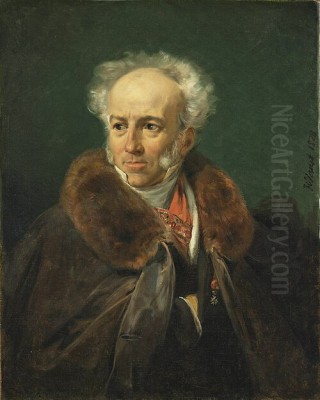
Jean-Baptiste Isabey (1767-1855) stands as a significant figure in French art history, a painter and miniaturist whose career spanned tumultuous decades of political upheaval and artistic transformation. Born in Nancy and dying in Paris, Isabey navigated the French Revolution, the rise and fall of Napoleon Bonaparte, the Bourbon Restoration, and the advent of the Second Empire, all while maintaining a position of prominence and favour among the ruling elite. Renowned primarily for his exquisite portrait miniatures, he also excelled in larger portraits, landscapes, and even embraced the newer technique of lithography. His work provides an invaluable visual record of the key personalities and the shifting tastes of late 18th and early 19th century France.
Early Life and Artistic Formation
Jean-Baptiste Isabey was born in Nancy, the capital of the Duchy of Lorraine, in 1767. His initial artistic training took place in his hometown under the guidance of Jean-Baptiste Charles Claudot, a painter associated with the Lorraine school. Seeking greater opportunities, the young Isabey made the pivotal decision to move to Paris around 1786. His talent quickly gained recognition, and remarkably, at the young age of nineteen, he secured a position as a court painter to the Marquise de Estrelles, an early indicator of his ability to charm and secure patronage within aristocratic circles.
His arrival in Paris marked a crucial phase in his development. He continued his studies, eventually entering the prestigious studio of Jacques-Louis David. This apprenticeship was transformative. David, the leading figure of Neoclassicism and a dominant force in the French art world, provided Isabey not only with advanced technical instruction, particularly in history painting, but also granted him access to the very heart of the Parisian artistic and intellectual milieu. Though Isabey would develop his own distinct style, the influence of David's Neoclassical emphasis on line, form, and idealized elegance remained a subtle undercurrent in his work.
Navigating Revolution and Empire
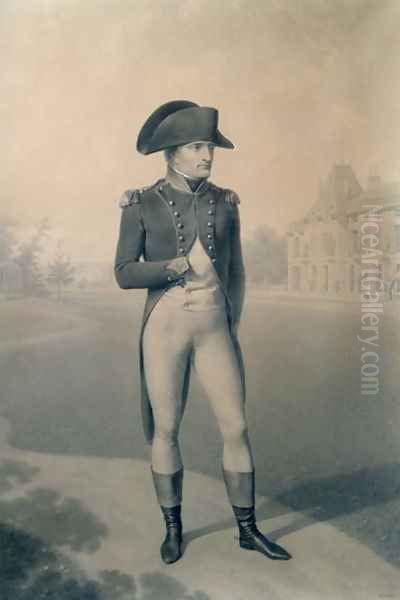
The French Revolution presented both challenges and opportunities for artists. While Isabey may have initially lost some aristocratic patrons due to the upheaval, his connections, including his association with David (who was deeply involved in the Revolution's cultural politics), helped him navigate the turbulent times. He demonstrated his adaptability by undertaking commissions that reflected the new political reality, notably creating portraits of some 228 members of the legislative assembly, contributing to the visual documentation of this critical period.
However, it was under Napoleon Bonaparte that Isabey's career reached its zenith. He became a favoured artist of the Consular and later the Imperial court. His exceptional skill in miniature painting, an art form highly valued for its intimacy and portability, made him particularly sought after by Napoleon and his family. He was appointed as one of the official painters to the Emperor, a role that brought him immense prestige and numerous commissions.
The Imperial Court Painter
Isabey developed a close working relationship with Napoleon and Empress Josephine, and later with Empress Marie-Louise. He produced a multitude of portraits of the imperial family and the court circle. These works were not merely likenesses; they were carefully crafted images that conveyed status, elegance, and the refined atmosphere of the Napoleonic court. His style, characterized by delicate brushwork, meticulous attention to detail, particularly in rendering fabrics and jewels, and an overall sense of grace, perfectly suited the tastes of the era.
One of his most famous works from this period is the portrait Napoleon at Malmaison. This intimate portrayal of the First Consul in the gardens of his private residence became highly influential and is often cited as one of the most lifelike representations of Napoleon. Another significant early work mentioned is his portrait of the Marquise de Estrelles, showcasing his early mastery. He was also deeply involved in the visual orchestration of imperial power, notably contributing designs for the costumes worn during Napoleon's coronation ceremony in 1804 and creating detailed sketches documenting the event itself. His portrait Napoleon presenting the Newborn King of Rome to Empress Marie Louise (1811) further cemented his role as a chronicler of the dynasty.
Master of the Miniature
While Isabey worked in various formats, his reputation rests significantly on his mastery of the portrait miniature. In the late 18th and early 19th centuries, miniatures, often painted on ivory, were highly fashionable. They served as intimate keepsakes, diplomatic gifts, and personal tokens of affection or loyalty. Isabey excelled in this demanding genre, becoming arguably the leading French miniaturist of his generation, rivalled perhaps by contemporaries like Augustin Ritt or Louis-Marie Sicard (Sicrardi).
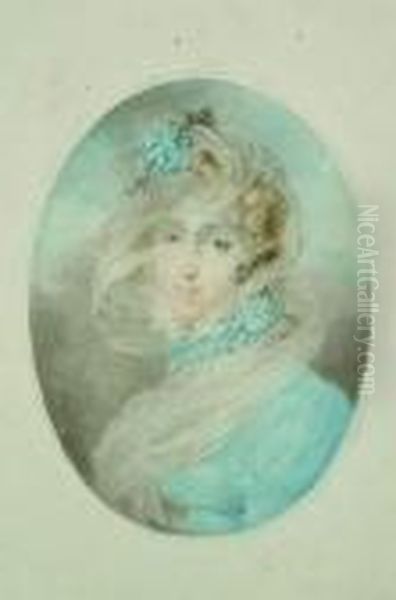
His miniatures are distinguished by their psychological insight, capturing not just a physical likeness but also a sense of the sitter's personality. The fineness of his technique allowed him to render subtle expressions and intricate details on a small scale with astonishing precision. He often employed a stippling technique alongside fine brushstrokes to achieve delicate modelling and luminous skin tones. These small treasures offered a private glimpse into the world of the powerful and famous, rendered with an elegance that defined Isabey's signature style.
Beyond Miniatures: Diverse Artistic Pursuits
Isabey's talents were not confined to miniature painting. He was also an accomplished painter of larger-scale portraits in oil, where he maintained his characteristic elegance and attention to individual character. These portraits often displayed a blend of Neoclassical structure, learned from David, with a softer, more graceful sensibility that sometimes bordered on the emerging Romantic sentiment, though without the dramatic intensity found in artists like Théodore Géricault or his son's friend, Eugène Delacroix. His approach remained closer to the polished refinement favoured by courtly society, akin perhaps in spirit, if not always in style, to contemporaries like François Gérard or Antoine-Jean Gros, who also navigated the demands of official portraiture.
Furthermore, Isabey explored landscape painting and watercolour. Works like his Normandy Seascape demonstrate his ability to capture atmospheric effects and natural beauty with a delicate touch and rich palette, earning praise when exhibited at the Paris Salon. His versatility extended to technical innovation; he was among the artists who embraced lithography in the late 18th and early 19th centuries. This printmaking technique allowed for the wider and more efficient reproduction of images, enabling Isabey to disseminate his compositions, including potentially larger works or studies, to a broader audience.
Chronicler of Political Change: Vienna and the Restoration
Isabey's ability to adapt to shifting political tides was remarkable. After Napoleon's final defeat, he seamlessly transitioned his services to the restored Bourbon monarchy. His established reputation and diplomatic skills likely aided this transition. A testament to his international standing was his appointment as the official portraitist for the Congress of Vienna in 1814-1815. This major diplomatic event brought together the leaders of Europe to reshape the continent after the Napoleonic Wars.
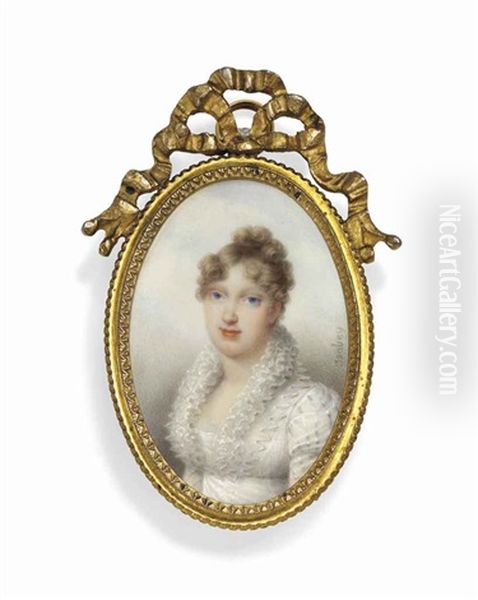
Isabey was tasked with capturing the likenesses of the key figures attending the Congress, such as Talleyrand and Metternich. An amusing anecdote survives from this period: faced with the complexity of arranging group portraits of the numerous dignitaries, Isabey reportedly used dolls or mannequins dressed in miniature versions of their attire to plan his compositions. This engagement solidified his role not just as a court painter, but as a visual historian recording a pivotal moment in European history. He continued to serve the French monarchy under Louis XVIII and Charles X, demonstrating his enduring appeal across different regimes.
Later Years, Family, and Legacy
Isabey's long life continued into the mid-19th century. In 1817, he married Laure Jeanne Salomon. The couple had several children, most notably Eugène Isabey (1803-1886), who followed in his father's footsteps to become a respected painter in his own right. Eugène, however, moved away from his father's polished style, embracing a more Romantic approach, particularly renowned for his dramatic marine paintings and vibrant watercolours. Eugène Isabey travelled with Eugène Delacroix to England in 1825, where they encountered artists like Richard Parkes Bonington, absorbing influences from the British landscape and watercolour traditions.
Jean-Baptiste Isabey himself experienced personal tragedies, including the loss of a son and his wife, but he remained active professionally. He witnessed the rise of Napoleon III and the Second Empire, even serving as an advisor to the new Emperor. Despite the advent of photography, a medium he reportedly viewed critically for its inability to capture the "soul," Isabey continued to receive recognition. He was awarded the Legion of Honour (eventually becoming a Commander) and was made a member of the Royal Academy of Painting in 1832. He died in Paris on April 18, 1855, at the advanced age of 78, and was buried in the prestigious Père Lachaise Cemetery.
Artistic Connections and Influence
Isabey's career was interwoven with the major artistic figures of his time. His tutelage under Jacques-Louis David placed him at the epicentre of Neoclassicism. While he developed a more delicate and less severe style than his master, the foundational principles learned in David's studio remained. He worked alongside and competed with other prominent artists serving the Napoleonic court, including François Gérard, Antoine-Jean Gros, Pierre-Paul Prud'hon, and Anne-Louis Girodet.
His influence extended directly to his son, Eugène, whom he taught. Through Eugène's friendships, particularly with Delacroix and Bonington, the Isabey name remained connected to the forefront of the Romantic movement, even as Jean-Baptiste's own style retained its Neoclassical grace. While perhaps not as revolutionary as David or possessing the austere classicism of Jean-Auguste-Dominique Ingres, Isabey carved a unique niche, blending precision with elegance.
Exhibitions and Recognition
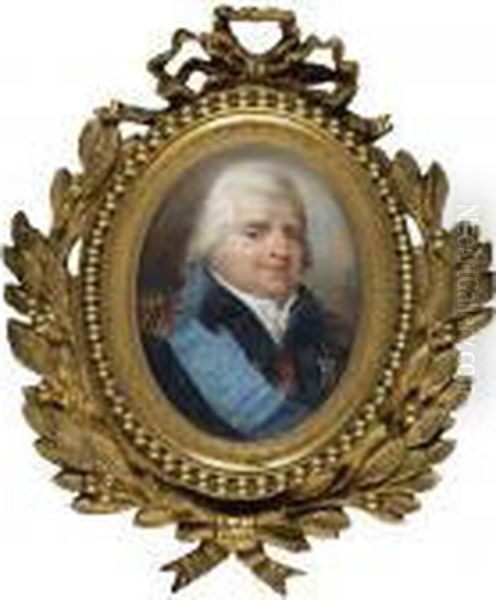
Throughout his career, Isabey's works were regularly displayed at the Paris Salon, the premier art exhibition of the time, where they generally received favourable notice. His status ensured his inclusion in significant exhibitions even posthumously. Specific works like La Reine Hortense were featured in thematic exhibitions such as "Jean-Baptiste Isabey - portraitiste de l'Europe" at the Château de Malmaison. His Napoleon presenting the Newborn King of Rome appeared in auctions and shows focused on French history.
His miniatures continue to be studied and exhibited, featuring in collections and exhibitions dedicated to the art form, such as those held at major institutions like The Metropolitan Museum of Art. His association with Napoleon ensures his works are frequently included in exhibitions exploring the Napoleonic era, like "Les Trésors de Napoléon" held in Montreal. These presentations underscore his historical importance and the enduring appeal of his artistry.
Conclusion: Isabey's Place in Art History
Jean-Baptiste Isabey occupies a distinct and important place in French art history. He was the preeminent portrait miniaturist of his era in France, capturing the likenesses of Europe's elite with unparalleled delicacy and psychological nuance. His career serves as a fascinating case study in artistic adaptability, successfully navigating the dramatic political shifts from monarchy through revolution, empire, and restoration, back to empire.
While his name today might not resonate as loudly as David, Ingres, or Delacroix, his contribution was immense. He was a master craftsman, a skilled courtier, and a vital visual chronicler of his time. Through his portraits and miniatures, he provided an intimate window into the personalities and the refined aesthetics of a transformative period in French and European history. His elegant style, technical brilliance, and ability to capture the essence of his sitters ensure his continued relevance and appreciation.